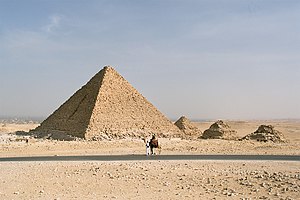Pyramid of Menkaure
| Pyramid of Menkaure | |
|---|---|
 |
|
| Menkaure | |
| Coordinates | 29°58′21″N 31°07′42″E / 29.97250°N 31.12833°ECoordinates: 29°58′21″N 31°07′42″E / 29.97250°N 31.12833°E |
| Ancient name | Menkaure is Divine |
| Constructed | c. 2510 BC (4th dynasty) |
| Type | True Pyramid |
| Material |
limestone, core red granite, white limestone, casing |
| Height | 65 metres (213 ft) or 125 cubits (original) |
| Base | 102.2 by 104.6 metres (335 ft × 343 ft) or 200 cubits (original) |
| Volume | 235,183 cubic metres (8,305,409 cu ft) |
| Slope | 51°20'25 |
The Pyramid of Menkaure, located on the Giza Plateau in the southwestern outskirts of Cairo, Egypt, is the smallest of the three main Pyramids of Giza. It is thought to have been built to serve as the tomb of the fourth dynasty Egyptian Pharaoh Menkaure.
Menkaure's pyramid had an original height of 65.5 metres (215 feet) and was the smallest of the three major pyramids at the Giza Necropolis. It now stands at 61 m (204 ft) tall with a base of 108.5 m. Its angle of incline is approximately 51°20′25″. It was constructed of limestone and granite. The first sixteen courses of the exterior were made of red granite. The upper portion was cased in the normal manner with Tura limestone. Part of the granite was left in the rough. Incomplete projects such as this pyramid help archaeologists understand the methods used to build pyramids and temples. South of the pyramid of Menkaure are three satellite pyramids that are each accompanied with a temple and have a substructure. The southernmost is the largest and a true pyramid. It's casing is partly of granite, like the main pyramid, and is believed to have been completed due to the limestone pyramidion found close by. Neither of the other two progressed beyond the construction of the inner core.
In the mortuary temple the foundations and the inner core were made of limestone. The floors were begun with granite and granite facings were added to some of the walls. The foundations of the valley temple were made of stone. However both temples were finished with crude bricks. Reisner estimated that some of the blocks of local stone in the walls of the mortuary temple weighed as much as 220 tons, while the heaviest granite ashlars imported from Aswan weighed more than 30 tons. It was not unusual for a son or successor to complete a temple when a Pharaoh died, so it is not unreasonable to assume that Shepseskaf finished the temples with crude brick. There was an inscription in the mortuary temple that said he "made it (the temple) as his monument for his father, the king of upper and lower Egypt." During excavations of the temples Reisner found a large number of statues mostly of Menkaure alone and as a member of a group. These were all carved in the naturalistic style of the old kingdom with a high degree of detail evident.
...
Wikipedia
